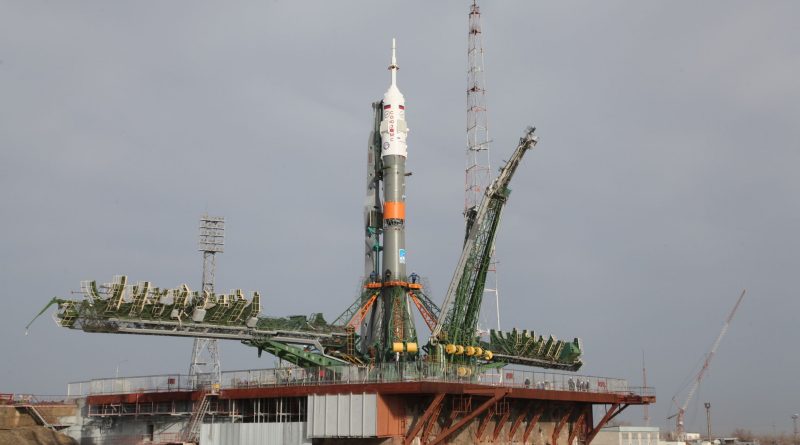Soyuz Rocket Moved to Baikonur Launch Pad for Nighttime Liftoff with All-Veteran Crew Trio
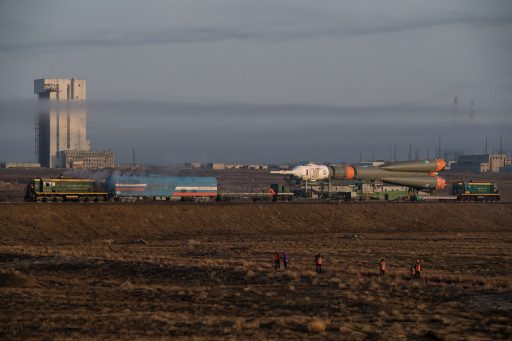
Russia’s Soyuz FG rocket rolled out to its historic launch pad at Kazakhstan’s Baikonur Cosmodrome under waves of early morning fog on Monday in preparation for liftoff with an all-veteran crew on Wednesday to send them off on a half-year Expedition to the International Space Station.
Taking its vertical liftoff position, the 50-meter tall rocket remains on track for launch at 17:44:23 UTC on March 21st with the Soyuz MS-08 spacecraft crewed by Oleg Artemyev of Roscosmos and NASA’s Drew Feustel and Ricky Arnold. Liftoff from Baikonur’s Site 1/5 will mark the start of a nine-minute rumble into orbit atop the 1,186th Soyuz rocket, the 510th to take off from “Gagarin’s Start.”
Soyuz MS-08 will stick to the conventional two-day flight profile, approaching the Space Station for a fully automated docking on Friday to kick off a planned stay of 158 days.
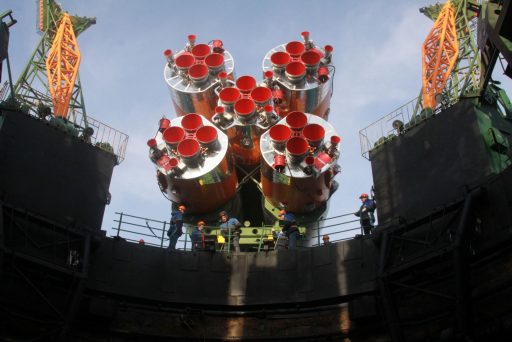
Dawn was about to break over the storied Cosmodrome when the 63rd Soyuz FG rocket emerged from its MIK assembly hall where it had finished integration on Saturday via the attachment of the seven-metric-ton spacecraft. Rolling out in frigid temperatures, Soyuz was greeted by a colorful sunrise as it progressed to the launch pad, eventually crossing the gates into the ‘Dangerous Zone’ around Site 1/5 to take its vertical launch position for two days of detailed checkouts to clear the way for countdown operations on Wednesday.
Soaring into the night over the Baikonur Cosmodrome, Soyuz will be flying under the call sign ‘Hawaii’ – chosen by first-time commander Oleg Artemyev who is embarking on his second long-duration flight to ISS after spending 169 days off the planet in 2014. He is deeply familiar with readying for Soyuz launches, having worked as an engineer at spacecraft builder Energia since 1998 where his duties included processing Soyuz spacecraft at the Baikonur Cosmodrome in the last weeks leading up to liftoff before eventually getting a chance to fly himself.
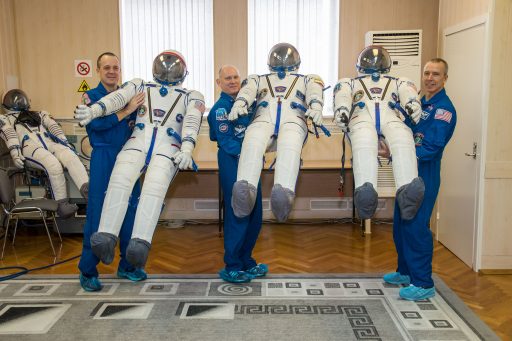
Artemyev will be flanked by NASA Astronauts and first-time Soyuz fliers Drew Feustel and Ricky Arnold – both veterans of Space Shuttle missions.
Feustel, riding in the ‘co-pilot’ position to the left, previously flew on two Space Shuttle missions including the last servicing mission to the Hubble Space Telescope. A trained Geologist, Feustel was selected by NASA in 2000 and accumulated 28 days in orbit on his Hubble mission and the final flight of Space Shuttle Endeavour that delivered the AMS-2 dark matter hunter to the International Space Station.
Ricky Arnold visited the International Space Station in 2009 as part of the STS-119 mission that delivered the final Truss Segment and Solar Array Wing to complete the Integrated Truss Structure acting as the structural backbone of the orbiting laboratory.
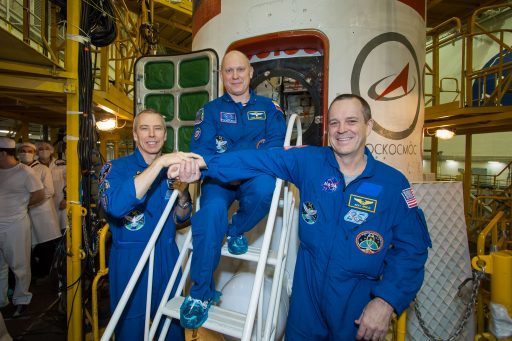
Both Arnold and Feustel are experienced spacewalks with 13 and 42 hours of EVA time, respectively, gearing up to add to their records less than a week after arriving on Station as an EVA was added into the Station’s schedule on March 29. The 6.5-hour excursion will see Feustel and Arnold install wireless communications equipment in preparation for the ECOSTRESS external payload arriving at ISS in June and continue outfitting the C2V2 communications system that will carry voice and data for commercial crew vehicles beginning arriving at ISS via initial test flights later this year.
The crew’s stint as part of ISS Expedition 55 and 56 will see additional EVAs in the spring and into the summer from both segments of the Space Station and up to six visiting vehicles are planned to arrive over the course of their tenure. However, their primary focus will be on science with well over 250 investigations active during Expedition 55/56, beginning in earnest with the arrival of Dragon SpX-14 in early April that will give the U.S. crew members plenty of experiments to complete between the craft’s arrival and departure.
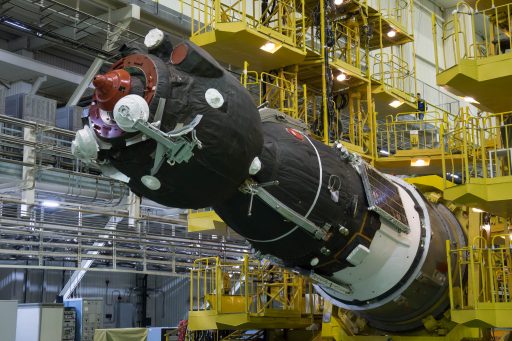
With their launch date fast approaching, Artemyev, Feustel and Arnold sat out Monday’s Soyuz rollout per tradition while their backups, veteran Cosmonaut Aleksey Ovchinin and NASA’s Nick Hague, had a chance to see the Soyuz roll to the launch pad. The two crews have been at Baikonur since March 4 for a two-and-a-half-week flow of launch campaign activities.
They completed their first visit to the Soyuz MS-08 spacecraft on March 5th for a suited ingress rehearsal and flight control checkout on the spacecraft before the Soyuz departed for several days of hazardous processing to receive propellants for its half-year mission. On the crew’s schedule were a number of traditional ceremonies leading up to launches from Baikonur, including the traditional tree-planting for first-time Soyuz fliers Feustel and Arnold. They also completed final simulations and tagged up with recovery forces who will be on standby beneath their ascent track for the unlikely event of an aborted launch.
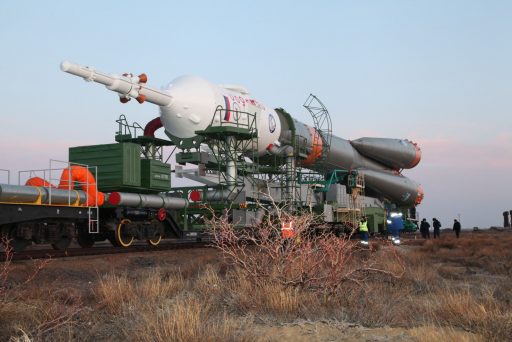
The prime and backup crews had a final visit to the Soyuz MS-08 spacecraft on Friday to familiarize themselves with the situation on board and they also inspected the Progress MS-09 spacecraft currently undergoing processing for launch this summer. They visited their Soyuz FG rocket on Friday before it completed final integration work on Saturday ahead of its early morning rollout on Monday.
While Soyuz completes final checkouts out on the launch pad, the three crew members will enjoy some quiet time before blasting off on their mission. They will participate in the traditional State Commission meeting on Tuesday to be officially cleared for launch followed by the final pre-launch press conference with members of the media present at Baikonur.
Preparations remain on track for a nighttime liftoff at 11:44:25 p.m. local time on Wednesday on a nine-minute climb atop the Soyuz FG rocket to lift the Soyuz spacecraft into a 200-Kilometer Low Earth Orbit from where it will ascend to the Space Station’s orbital altitude of 400 Kilometers. Soyuz MS-08 is planned to dock to the space-facing Poisk module at 19:41 UTC on Friday, March 23rd, to be followed by batch opening at 21:35 UTC to allow the incumbent ISS crew of Anton Shkaplerov, Scott Tingle and Norishige Kanai to welcome their fellow Expedition 55 crew members aboard the orbiting complex for over two months of joint operations.
Detailed Countdown & Launch Overview
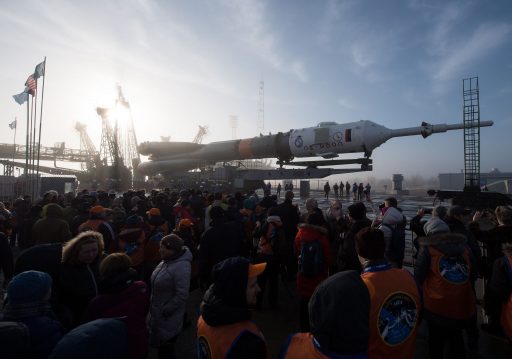
Out at Site 1/5, engineers will initiate the countdown sequence around eight hours prior to launch with the final set of fueling preparations. Once the two vehicles are activated, the Soyuz rocket and spacecraft complete a series of checkouts – communication checks, electrical testing and propulsion system testing is performed in the early stages of the countdown. Completing final hands-on work on the launch vehicle, engineers will install batteries on the booster and remove protective covers before standing by to receive a GO for propellant loading.
Five hours and 30 minutes ahead of launch, the Russian State Commission will meet to look at the overall status of the countdown and the results of launch vehicle and spacecraft testing to provide official approval for the beginning of tanking. By that time, the tanking cars will have already been rolled up to the pad and hooked up to Ground Support Equipment used to deliver propellants to the Soyuz launch vehicle.
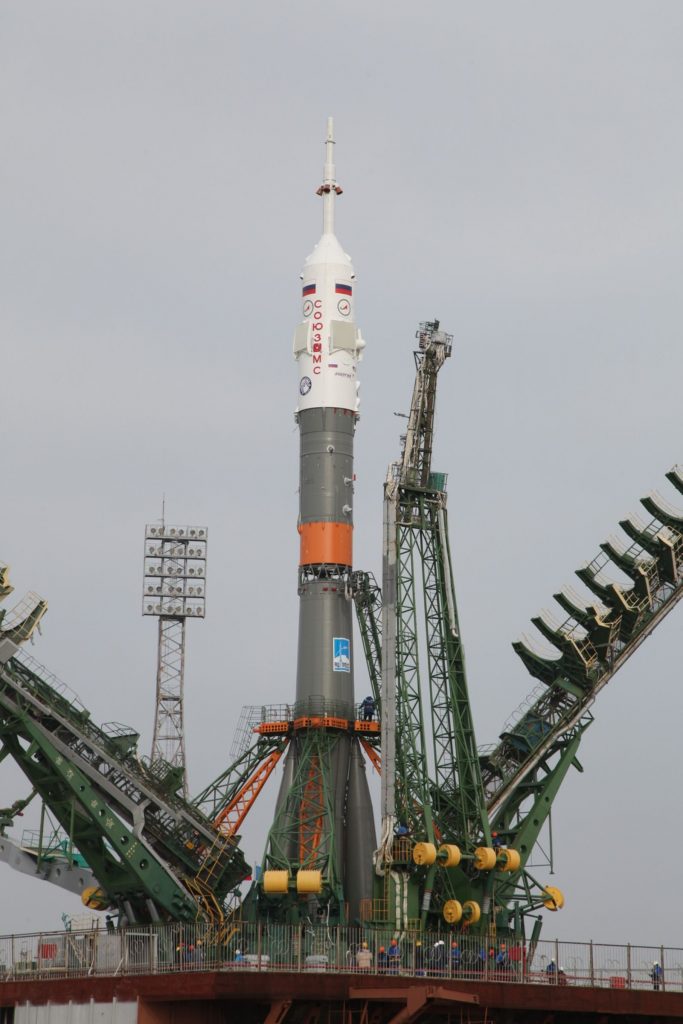
Soyuz FG stands 49.5 meters tall and weighs 305,000 Kilograms when fully fueled. It can lift up to 7,200 Kilograms into Low Earth Orbit using a two-stage stack plus four liquid-fueled boosters clustered around the Core Stage – based on the original R7 design by Sergei Korolev.
Each of the boosters is 19.6m long consisting of a tapered and a cylindrical section with a maximum diameter of 2.68m and a launch mass of 43,410 Kilograms. Installed on each booster is a four-chamber RD-107A engine delivering 838.5 Kilonewtons of sea level thrust. The Core Stage is ignited with the boosters and continues to burn after the boosters separate, acting as combined first and second stage. It is 27.8m tall and 2.95 meters in diameter with a total launch mass of 99,500kg, featuring a 792-Kilonewton RD-108A engine and four verniers for vehicle control.
Sitting atop the Core Stage is the Block I third stage that is 6.74m long, 2.66m in diameter and weighs 25,300 Kilograms powered by a four-chamber RD-0110 engine with four vernier thrusters for vehicle control.
Over the course of a two-hour sequence, the boosters, the large Core Stage and the third stage are loaded with a total of 274,140 Kilograms of refined Kerosene and –183°C Liquid Oxygen. Additionally, the boosters and core stage will receive liquid Nitrogen to be heated during flight in order to pressurize the propellant tanks. At around L-3 hrs & 30 min, the boosters and core stage will be loaded with Hydrogen Peroxide to power the engine turbopumps during flight.
Around L-3 hours, the crew will depart Site 254, reporting to officials and boarding a bus for a half-hour ride to Site 1/5 that is hosting its 510th launch. Getting off their bus, the crew members will have a look at their fully fueled rocket, take a few photos with officials present at the pad and walk over to the Service Structure stairs to wave good-bye and enter the elevator taking them up to their Soyuz for crew ingress.
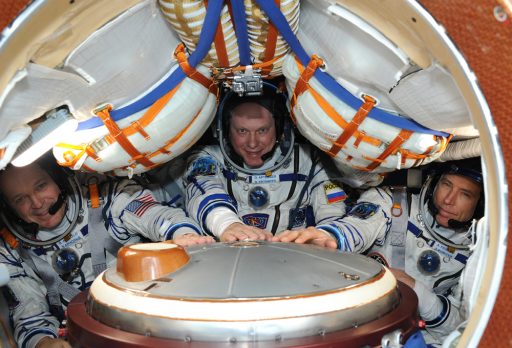
Climbing into the Soyuz through a hatch inside the Launch Shroud, the crew members will – one by one – enter the Orbital Module through its side hatch before climbing down through the Entry Module’s hatch to reach their Kazbek seat liners in the confined space of the small spacecraft.
Leak checks on the spacecraft pick up as soon as Soyuz has been sealed off and the crew will begin working through their pre-launch checklist that will take them about one hour to complete. 60 minutes ahead of launch, the Guidance System is activated and the flight computers receive their flight software 15 minutes later.
As hands-on work at the pad wraps up, teams will retract the two halves of the Soyuz Service Structure at L-40 minutes and put all ground systems in a safe configuration. Half an hour before T-0, the Launch Abort System will be activated and switched to automatic mode – ready to pull the Soyuz to safety in case of any serious problems.
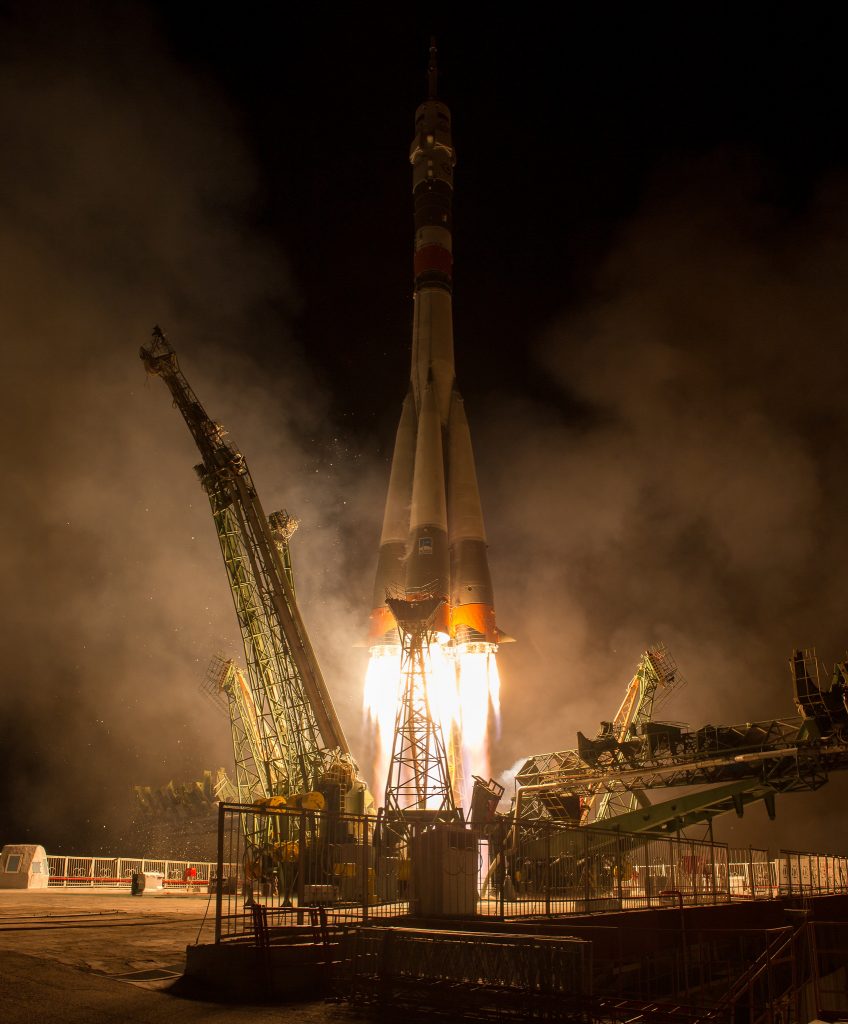
14 minutes ahead of launch, the Soyuz spacecraft is transferred to battery power and at L-10 minutes, the Soyuz FG inertial guidance system is configured for flight as gyros are uncaged and flight recorders are activated. Entering the Automated Countdown Sequence at T-6 minutes, the Soyuz launch vehicle will begin its final reconfigurations as part of a highly choreographed procedure.
Three minutes before launch, the five engines of the boosters and core stage are purged with nitrogen before propellant tank pressurization starts at T-2:35. Transfer to internal power occurs one minute before liftoff and Soyuz enables its Auto Sequencer that controls the final countdown events, coinciding with the retraction of the third stage umbilical mast from the rocket.
With the Auto Sequencer in control of the countdown, the Soyuz starts its ignition sequence at T-20 seconds as the turbopumps of the booster and core stage engines soar to flight speed and the engines reach an intermediate thrust level before being throttled up to full thrust for liftoff.
Blastoff is set for precisely 17:44:25 UTC, the optimized launch time based on the latest tracking data of the International Space Station. As clocks hit zero, Soyuz will begin rising from its launch pad with a total launch thrust of 422 metric tons, embarking on a nine-minute ascent mission following the usual flight profile.
Soyuz FG passes through Maximum Dynamic Pressure and Mach 1 a little over 70 seconds into the flight, being powered by the RD-107A engines of the boosters and the RD-108A of the core. The Launch Abort System jettisons its Escape Tower at 114 seconds into the mission, marking the transition from low- to mid-altitude abort mode in a system that provides launch abort capability all the way to orbital insertion.
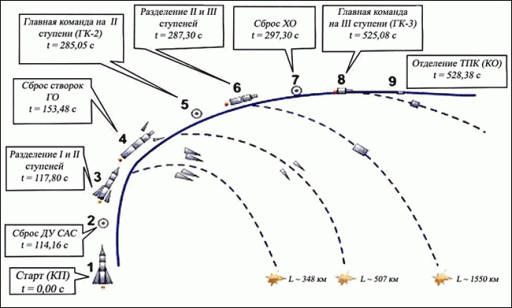
The four boosters and their RD-107A engines will burn for 1 minute and 58 seconds consuming a total of 39,600kg of propellants each to provide extra boost to the vehicle. After shutdown at an altitude of 49 Kilometers, the boosters are jettisoned from the core for a crash landing 348 Kilometers downrange.
With the boosters tumbling away from the Soyuz rocket, propulsion will only be provided by the Core Stage’s engine, delivering a thrust of 102,000 Kilogram-force when flying in the upper atmosphere. Two minutes and 37 seconds after launch, Soyuz will be over 80 Kilometers in altitude and jettison its protective Launch Shroud giving the crew a view outside through their small Entry Module windows, but the crew members will be focused on their displays, tracking the progress of their ascent into orbit.
Four minutes and 45 seconds into the flight, the Core Stage will shut down its engine, marking the beginning of the hot staging sequence. Two seconds after cutoff, the third stage’s RD-0110 engine will be commanded to ignite and, at the same time, pyrotechnic bolts in the interstage will be fired to severe the connection between the empty Core Stage and the upper stage of the Soyuz that will continue powered ascent while the core heads toward re-entry and impact 1,570 Kilometers downrange from the launch site.
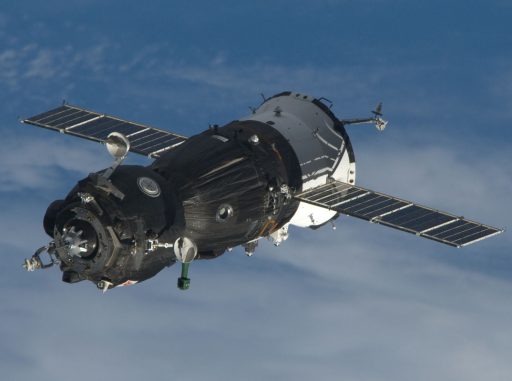
The third stage will fire its four-chamber engine and four gimbaling verniers for vehicle control until T+8 minutes and 45 seconds to achieve the planned insertion orbit. Just over two seconds after engine shutdown, the Soyuz spacecraft will separate from its rocket stage which itself will open up an oxygen valve to move away from the spacecraft.
Soyuz MS-08 is targeting the standard insertion orbit of 200 by 242 Kilometers inclined 51.67° from where the spacecraft will climb to meet up with ISS, currently orbiting at 403 by 406 Kilometers.
Immediately after separation from the carrier rocket, the Soyuz spacecraft will begin executing a series of time-tagged commands with deployment of the two power-generating solar arrays and KURS antennas planned eight seconds after the separation signal is received. After initial pressure integrity checks, the crew will be allowed to open their helmets and get comfortable for their first several orbits – dedicated to additional vehicle checks and a pair of critical engine burns.
A pair of engine burns is planned for the third orbit of the mission to lift the Soyuz from the initial orbit into an orbit over 300 Kilometers in altitude. Settling in aboard their Soyuz and going to sleep on their sixth lap around ISS, the trio can look forward to a quiet day on Thursday dedicated to a manual attitude control test using a subset of the spacecraft’s thrusters as well as a small orbital correction on Orbit #17.
Soyuz is expected on the Station’s doorstep on Friday, making an automated approach to dock with the Poisk module at 19:41 UTC to top up the Expedition 55 crew.

